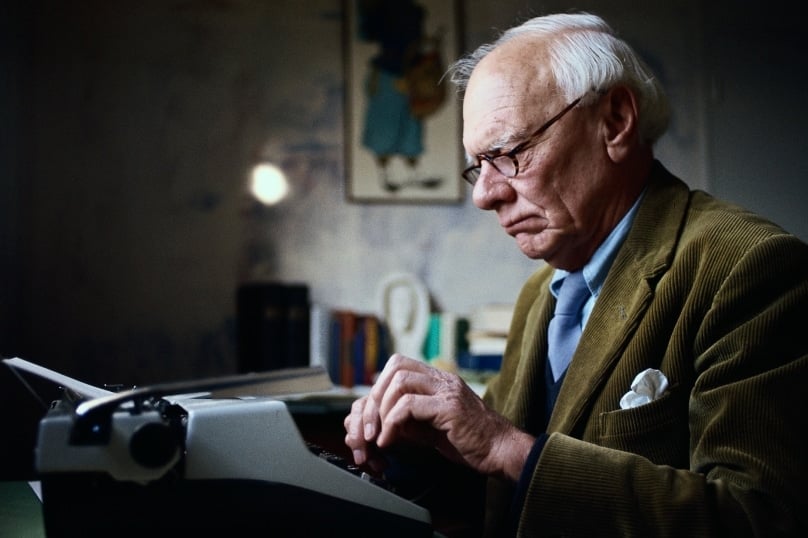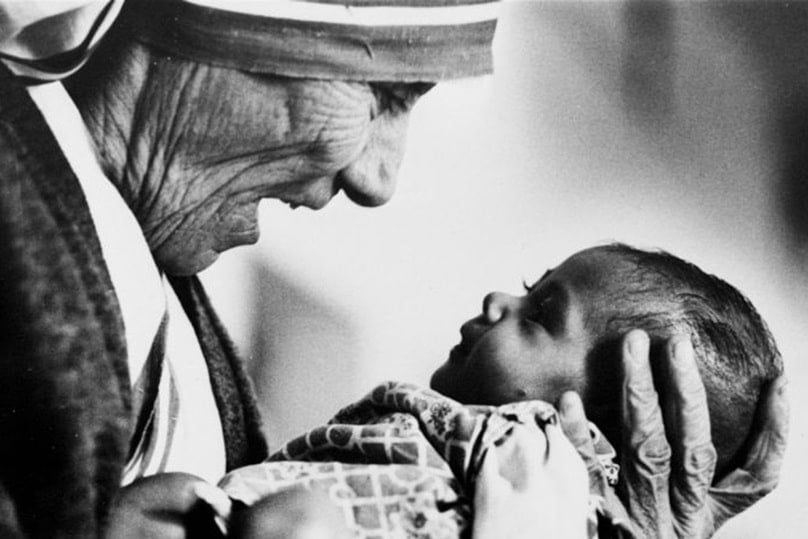
By the time of her death in 1997, Mother Teresa was internationally famous. Her white sari with a blue border, enclosing a deeply lined face often smiling, was widely familiar, and her mission among ‘the poorest of the poor’, in Calcutta and elsewhere, was celebrated by popes and presidents alike, as well as by vast numbers of ordinary people.
From the late 1940s, when she set about founding her Order, the Missionaries of Charity, Mother Teresa attracted popular interest in India and surrounding countries.
But it was only in 1968 that she was catapulted to world prominence by a TV interview conducted by the British journalist Malcolm Muggeridge, followed by a special TV program he made in Calcutta called Something Beautiful for God.
Muggeridge was by then a world-renowned author and TV personality. He had been a newspaper correspondent and columnist in various countries – including Australia for several months in 1958 – and had achieved international fame for his interviews and documentaries.
Yet he was in some ways an unlikely choice for interviewing Mother Teresa. He was well-known as a religious sceptic, possessed of a corrosive wit and a penchant for mocking cherished beliefs and institutions.
In 1955, he provoked outrage when he described the British monarchy as a ‘Royal Soap Opera’. A year later, in Australia, he ruffled feathers with his criticism of the British Commonwealth and his description of Australia as a ‘second-hand’ country, which had not managed to shake off its anachronistic loyalty to England but was now being absorbed by the facile conformities of mass American culture.
At the same time, he had a long history of interest in spiritual matters and moral concerns, even if these were disguised by a cynical, and at times caustic, public persona.
A series of journalistic opportunities occurred in his life that highlighted and advanced his experience of life as a spiritual journey. In the 1920s, soon after he graduated from Cambridge University, he taught at a Christian college in India – a country, as his biographer Gregory Wolfe has noted, that “would haunt his imagination for the rest of his life”.
In the early 1930s, he went to Russia as a newspaper correspondent, at the height of Stalin’s reign of terror. He had previously flirted with Communism and nourished the hope of a socialist paradise in Russia, but his exposure to the barbarities of the Soviet regime shattered these illusions.
His compassion was aroused by the widespread suffering of the people, particularly in Ukraine where millions perished as a result of Stalin’s forced collectivisation of agriculture.
Muggeridge was one of the first Western journalists to report honestly on the famine, and he was later awarded the Ukrainian Order of Freedom.
But his time in Russia was also spiritually decisive. He found himself in the midst of a deeply religious culture, and his visit to a church in Kiev one Sunday morning was the occasion of an almost mystical experience, when the spectacle of people turning to God in their afflictions brought home to him most powerfully the truth of the Easter proclamation, ‘Christ is Risen.’
A year later, Muggeridge returned to India to serve on a newspaper in Calcutta – an early exposure to the city that, several decades later, acquired new significance in his life as the setting for Mother Teresa’s missionary work.
I have a personal memory of Muggeridge speaking about Mother Teresa, when I attended a conference in 1978 in San Francisco on the 10th anniversary of Pope Paul VI’s encyclical, Humanae Vitae.
Both he and Mother Teresa were expected to speak but, in the event, Mother Teresa fell ill and only Muggeridge was present. In his opening remarks, he paid a moving tribute to her.
He extolled the Church’s opposition to contraception as being teaching of the most profound and prophetic kind. He believed that reaffirming a belief in human dignity at the very source of life was truly consistent with Mother Teresa’s care for those in later life – exemplified in her love for the derelict and the dying in the slums of Calcutta and elsewhere.
Muggeridge often recalled a scene recorded in the TV program, Something Beautiful for God. Mother Teresa was holding a baby girl in her hands – so tiny that her very existence seemed miraculous. She exclaimed, with a glowing and exalted expression on her face: “See! There’s life in her!” It was for Muggeridge a triumphant glorying in life – “a divine flame”, he said, “which no man dare presume to put out, be his motives never so humane and enlightened”.

Mother Teresa endured spiritual trials in her living out of Christ’s love, as Pope John Paul II mentioned in the Mass in October 2003 celebrating her beatification. In a letter to her spiritual adviser, she confessed to long years of inner darkness:
“I want to love him as he has not been loved, and yet there is that separation, that terrible emptiness, that feeling of absence of God.”
Mother Teresa was intensely aware of the “dark night of the soul”, which St John of the Cross described and many saints have experienced – a form of suffering exemplified by Christ himself, when he cried out on the cross. In the striking words of Chesterton, this was when God himself seemed for an instant to be an atheist: “My God, My God, why have you forsaken me?”
In Muggeridge’s mind, Mother Teresa’s experience of inner darkness added to her appeal. He counted himself, as he wrote in his autobiography, among “the walking-wounded from the ideological conflicts of the age”, and he was conscious of that “terrible emptiness” to which Mother Teresa testified – the spiritual poverty afflicting human beings everywhere but especially those in the West who are starved for love in the midst of plenty.
Like her namesake St Teresa of Avila, Mother Teresa not only had mystical insight but also practical acumen. Muggeridge was surprised – and hugely impressed – by her organisational shrewdness and efficiency, managing an order of sisters spread beyond India to various countries across the globe, including Australia.
He admired her raffling off the ceremonial car which Pope Paul VI presented to her after his visit to India in 1964. The proceeds enabled her to establish a leper colony.
“The rich, when they come to her,” remarked Muggeridge, “are liable to leave a little less rich, which she considers is conferring a great favour on them”.
This blending of spiritual and worldly understanding arose from her abandonment of self in devotion to Christ: “in abolishing herself”, Muggeridge said, “she found herself, by virtue of that unique Christian transformation, manifested in the Crucifixion and the Resurrection, whereby we die in order to live”.
There was a special challenge that confronted Mother Teresa, and indeed Muggeridge, as people seeking to respond to God’s grace in a media-saturated society. How to deal with the contradictions of media prominence, exerting a wide influence while resisting the absorptions of publicity and the claims of celebrity status?
A vital part of the answer was the depth of Mother Teresa’s spiritual life – her devotion to prayer which, she told Muggeridge, “enlarges the heart until it is capable of containing God’s gift of himself”.
Each morning during the filming of Something Beautiful for God, Muggeridge attended Mass with Mother Teresa and the Sisters. He was not, at that point, a Catholic – only later, in 1982, was he received into the Church in company with his wife Kitty – but he recognised the spiritual sustenance Mother Teresa drew from her daily Mass.
She told him that, without it, she could not get through a single day or hour of the life of dedication she had chosen.
Mother Teresa joins the saints of history in taking us to the heart of the Christian mystery. Each generation, GK Chesterton suggested, is converted by the saint who contradicts it most. He was referring to St Francis of Assisi, and Pope Francis has captured in a single phrase the particular model represented by Mother Teresa for our time – that she is the conclusive response to what the pope has called “the throwaway society”. Mother Teresa picked up the throwaways and brought them within the folds of Christ’s love.
It is hard to think of a more stunning saint for today’s West – and today’s world.
